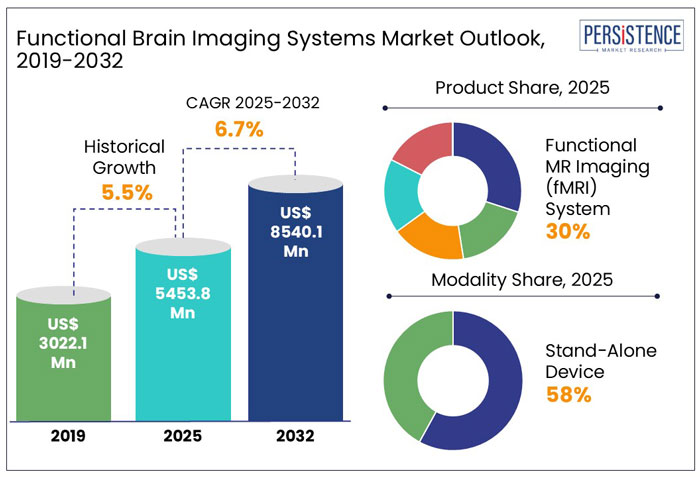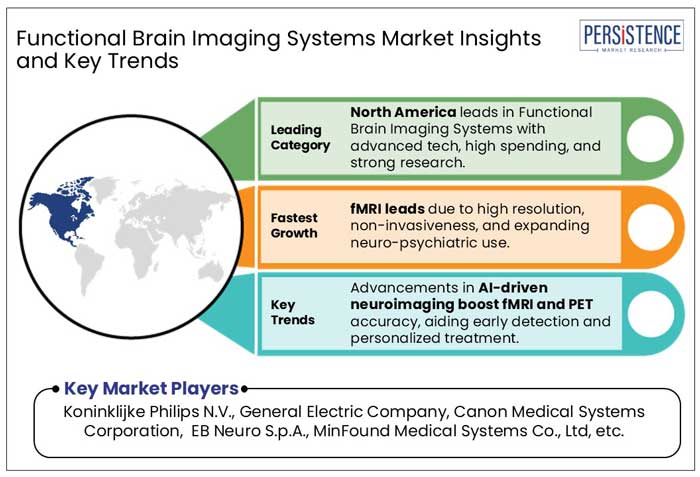ID: PMRREP23050| 310 Pages | 6 Mar 2025 | Format: PDF, Excel, PPT* | Healthcare

The global Functional Brain Imaging Systems Market size is projected to rise from US$ 5,453.8 million in 2025 to 8,540.2 million in 2032. The market is anticipated to exhibit a significant/considerable CAGR of 6.7% during the forecast period from 2025-2032.

| Attributes | Key Insights |
|---|---|
|
Functional Brain Imaging Systems Market Size (2025) |
US$ 5,453.8 Mn |
|
Projected Market Value (2032) |
US$ 8,540.2 Mn |
|
Global Market Growth Rate (2025-2032) |
6.7% CAGR |
|
Market Share of Top 5 Countries |
63.3% |
According to Persistence Market Research, the functional brain imaging systems market is experiencing significant growth, driven by advancements in neuroimaging technologies and increasing demand for early diagnosis of neurological disorders. These systems, including functional magnetic resonance imaging (fMRI), positron emission tomography (PET), and near-infrared spectroscopy (NIRS), enable real-time assessment of brain activity, aiding in the study of conditions such as Alzheimer’s disease, epilepsy, and traumatic brain injuries. The rising prevalence of neurodegenerative diseases and psychiatric disorders, coupled with expanding research in cognitive neuroscience, is propelling market expansion.
The global market recorded a historic CAGR of 5.5% from 2019 to 2024.
The Functional Brain Imaging Systems Market has witnessed steady growth historically, driven by advancements in neuroimaging technologies, increasing prevalence of neurological disorders, and expanding research in cognitive neuroscience.
Looking ahead, the Functional Brain Imaging Systems Market is expected to exhibit robust growth through 2032, propelled by technological innovations and the increasing use of imaging in personalized medicine. The emergence of portable and wearable neuroimaging devices will revolutionize the market, offering real-time brain monitoring in non-clinical settings. Additionally, rising investments in brain-computer interface (BCI) research, particularly for neuroprosthetics and mental health diagnostics applications, will drive market demand. The expanding role of functional brain imaging in psychiatric disorder evaluation, coupled with growing government funding for neuroscience research, will further boost adoption. With increasing collaborations between academia and industry, the market is poised for significant expansion, particularly in regions with advanced healthcare infrastructure such as North America and Europe.
“Technological Advancements in Imaging Systems”
Many brain signal monitoring technologies, including multichannel EEG and fMRI devices, have advanced due to advanced research and development effort and the rapid speed of improvements in embedded systems and microelectronics. It is hoped that these gadgets' new, sophisticated magnetic technologies would make it even simpler and faster to investigate the inner workings of the central nervous system (CNS).
Along with new device modalities for non-invasive active brain sensing, such as functional fNIR for real-life imaging and monitoring, major research firms are also developing long duration usable, downsized, and portable versions. In the near future, it is possible to see patients using these kinds of technologies on a regular basis for extended periods of time. These technologies can effortlessly capture, store, and intelligently communicate neurological information data with the end user.
“Increase in Number of Brain Aneurysm and Traumatic Brain Injury Cases”
The escalating incidence of brain aneurysms and traumatic brain injuries (TBIs) significantly propels the growth of the functional brain imaging systems market.
Globally, TBIs contribute to more deaths and disabilities than any other traumatic incident. These alarming statistics underscore the critical need for advanced diagnostic tools, such as functional brain imaging systems, to facilitate early detection and intervention.
“Advent of Portable and Wearable Functional Imaging Devices”
The advent of portable and wearable functional imaging devices is revolutionizing the functional brain imaging market by enabling real-time monitoring of brain activity in non-clinical settings such as homes, workplaces, and ambulatory care. Unlike traditional bulky neuroimaging equipment like fMRI or PET scanners, emerging wearable systems based on functional near-infrared spectroscopy (fNIRS) and electroencephalography (EEG) provide continuous, non-invasive brain activity tracking, expanding accessibility for patients and researchers alike.
Additionally, companies are integrating cloud-based analytics and AI-powered interpretation in wearable brain imaging, enabling real-time data processing and remote consultations. With increasing funding in 2025 for non-invasive neuroimaging startups and growing adoption in personalized neurology, the market for wearable functional imaging systems is expected to expand rapidly, bridging the gap between hospital-grade neuroimaging and everyday cognitive monitoring.
“High cost Imaging systems”
The high cost of functional brain imaging systems remains a significant barrier to market expansion, limiting accessibility for healthcare institutions, especially in low- and middle-income countries.
Many smaller hospitals and diagnostic centers struggle to adopt these high-cost systems, leading to a concentration of advanced imaging technologies in well-funded research institutions and large metropolitan hospitals. This disparity in access creates challenges in early diagnosis and treatment planning for neurological disorders such as Alzheimer’s disease, epilepsy, and traumatic brain injuries. Moreover, reimbursement complexities in several countries make it financially unviable for healthcare providers to justify the cost of these imaging procedures.
As cost-related challenges persist, the market gradually shifts towards portable and cost-effective imaging alternatives, AI-powered image processing, and cloud-based diagnostic platforms. However, unless manufacturers introduce more affordable solutions, the adoption of functional brain imaging systems will remain constrained, limiting overall market growth.
“Product Recalls and Safety Concerns”
In both MRI and MEG technology, high amplitude magnetic sensors must be positioned inside a super conductive shield area. These cannot be used outside of clinical environments due to their weight. Comfort and usability severely limit the possibility of these technologies to be utilized in long-term brain scans applications. Negative effects and challenges associated with their use, such as those in detecting a variety of disorders, such as attacks, malignancies, aneurysms, spine injuries, and brain dysfunction, may also limit the need for imaging equipment.
Why is the U.S. Market Booming?
“Rising Prevalence of Neurological Disorders”
The U.S. is expected to hold a significant market share in the global functional brain imaging systems market by the end of 2024.
The growing burden of neurological disorders such as Alzheimer’s disease, Parkinson’s disease, epilepsy, and brain tumors is significantly increasing the demand for functional brain imaging systems in the U.S. and North America. With an aging population, the incidence of neurodegenerative conditions is rising sharply.
Similarly, Parkinson’s disease affects nearly one million people in the U.S., a number expected to reach 1.2 million by 2030, according to the Parkinson’s Foundation. Functional imaging methods such as fMRI (functional magnetic resonance imaging) and PET (positron emission tomography) are playing a critical role in identifying biomarkers and assessing the effectiveness of emerging treatments. Additionally, epilepsy affects 3.4 million Americans, with advanced imaging being crucial in pre-surgical evaluations and seizure localization. The growing prevalence of these disorders, coupled with increasing government and private research investments, is making functional brain imaging an essential tool in neurology, accelerating its adoption across North America.
Will Germany Be a Lucrative Market for the Manufacturers?
“Strong Healthcare Infrastructure and High Investments in Medical Technology”
Germany’s healthcare system is one of the most advanced in Europe, with universal health coverage and significant public and private sector investments. The country allocates over 12% of its GDP to healthcare spending, translating into substantial financial support for hospitals, research institutions, and advanced medical technologies. The presence of over 1,900 hospitals, including specialized neurology centers and university-affiliated medical facilities, ensures widespread access to functional brain imaging systems such as fMRI, PET, and MEG scanners. These institutions are well-equipped with state-of-the-art diagnostic infrastructure, making Germany a hub for early disease detection and neuroimaging research.
How is Japan Emerging as a Prominent Market for Functional Brain Imaging Systems?
“Rising Prevalence of Rising Neurological Disorders”
One significant trend that is driving the demand for functional brain imaging is the rising prevalence of neurodegenerative diseases. The need for functional brain imaging for diagnostic purposes is being fuelled by the nation's growing awareness of brain health. Additionally, lifelong developmental neuroscience has caught the interest of the health sector. The market for functional brain imaging (fMRI) is growing as a result of all these factors.
Moreover, Japan’s government and healthcare industry are actively funding large-scale brain health initiatives to mitigate the economic and social impact of neurological disorders. The country is also witnessing an increase in AI-powered neuroimaging solutions, further enhancing diagnostic precision and enabling predictive analytics for high-risk elderly populations.
Which Product is Driving Growth of the Global Market?
“High Sensitivity and Spatial Resolution”
Functional Magnetic Resonance Imaging (fMRI) stands out as the leading segment in the Functional Brain Imaging Systems Market due to its exceptional spatial resolution (1-3 mm) and high sensitivity in detecting neural activity. Unlike other imaging techniques, fMRI captures dynamic changes in brain function by measuring blood-oxygen-level-dependent (BOLD) signals, providing a real-time, non-invasive assessment of brain activity at a fine structural level. This precision is crucial in diagnosing and studying complex neurological and psychiatric disorders, making fMRI the gold standard for functional brain mapping.
Which Modality is Expected to Dominate the Global Market?
“Increasing Incidence of CNS Disorders”
Stand-alone systems contributed the largest to the global market in 2024.
The stand-alone device segment dominates the Functional Brain Imaging Systems Market due to its higher imaging accuracy, advanced capabilities, and widespread adoption in hospitals, research centers, and diagnostic facilities. Unlike portable or wearable systems, stand-alone devices—such as high-field fMRI, MEG, and PET scanners—offer superior spatial and temporal resolution, making them the gold standard for neuroimaging.
Which End User is Expected to Emerge as a Market Leader in the Future?
“Increasing Number of Hospitals with Better Infrastructure”
Hospitals segment is expected to hold the larger share of about 52.4% by the end of 2025.
Some of the factors supporting the segment's growth include the increase in demand for high-tech imaging modalities and the incorporation of surgical suits with imaging equipment. H hospitals in several developed countries have seen a dramatic increase in demand for various treatment modalities. But the number of new hospitals in developing nations in the Asia-Pacific area has sharply increased.

The functional brain imaging systems market is competitive, with numerous significant competitors. The market is anticipated to benefit from the players' strategic activities.
Key instances include :
The market is projected to rise from US$ 5,453.8 million in 2025.
Sales of the market are set to witness growth at a CAGR of 6.7% and be valued at around US$ 8,540.2 Mn by 2032.
Demand for the market increased at a 5.5% CAGR from 2019 to 2024.
Innovations in EEG, fMRI, and wearable imaging devices are improving brain monitoring efficiency.
Rising cases of brain aneurysms and TBIs are driving the need for early diagnosis and treatment.
High costs limit accessibility, especially in smaller hospitals and developing regions.
| Attribute | Details |
|---|---|
|
Forecast Period |
2025-2032 |
|
Historical Data Available for |
2019-2024 |
|
Market Analysis Units |
Value: US$ Bn/Mn, Volume: As applicable |
|
Key Countries Covered |
|
|
Key Market Segments Covered |
|
| Report Highlights |
|
|
Key Companies’ Profile |
|
|
Customization & Pricing |
Available upon Request |
Product:
Modality:
End User:
Region:
Delivery Timelines
For more information on this report and its delivery timelines please get in touch with our sales team.
About Author